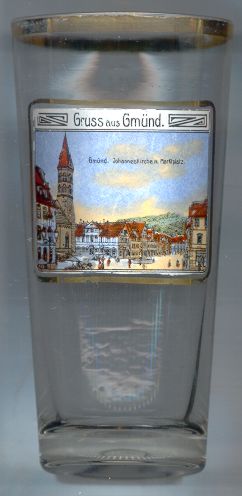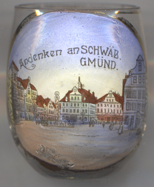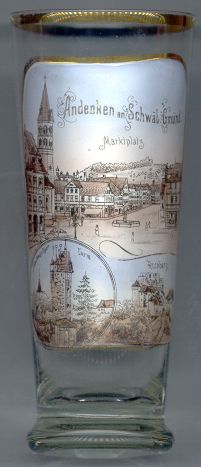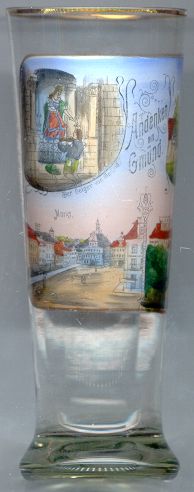

|
| DEUTSCHLAND | GERMANY |
| Bundesland: Baden-Württemberg | |
| Regierungsbezirk: Stuttgart | |
| Landkreis: Ostalbkreis |

 Schwäbisch Gmünd is situated at an elevation of 327 m on the river Rems in eastern Baden-Württemberg.
The first mention of "Gamundis" is found in a document of the 9th century. At some time during the reign of King Konrad III (1138–1152),
it received the status of a town; the earliest document mentioning this status dates from 1162. After the end of the Staufer dynasty in 1254,
the town's importance grew steadily and it finally had the status of a Free Imperial City. The town's wealth during the late middle ages and the early modern times
was based on trading in textiles and wine, and on manufacturing of scythes. Silver and gold workmanship became an important economic factor from the
17th century onward. After the Peace of Lunéville (1801) and the Reichsdeputationshauptschluss (1803), which reorganized the German territories, the
town lost its status of Free Imperial Town and was incorporated into the Kingdom of Württemberg; from 1805 onwards Gmünd was the official name of the city until 1934
when it was changed to Schwäbisch Gmünd.
A new economic upswing was initiated by the opening of the Remstalbahn railway line in 1861. Gmünd recovered its position as the most prominent German silver
working town during the 1890s. The district Schwäbisch Gmünd was reinstated in 1935/1938, but dissolved in 1972 when Schwäbisch Gmünd became part of the newly established
district Ostalbkreis with its administrative centre Aalen.
Schwäbisch Gmünd is situated at an elevation of 327 m on the river Rems in eastern Baden-Württemberg.
The first mention of "Gamundis" is found in a document of the 9th century. At some time during the reign of King Konrad III (1138–1152),
it received the status of a town; the earliest document mentioning this status dates from 1162. After the end of the Staufer dynasty in 1254,
the town's importance grew steadily and it finally had the status of a Free Imperial City. The town's wealth during the late middle ages and the early modern times
was based on trading in textiles and wine, and on manufacturing of scythes. Silver and gold workmanship became an important economic factor from the
17th century onward. After the Peace of Lunéville (1801) and the Reichsdeputationshauptschluss (1803), which reorganized the German territories, the
town lost its status of Free Imperial Town and was incorporated into the Kingdom of Württemberg; from 1805 onwards Gmünd was the official name of the city until 1934
when it was changed to Schwäbisch Gmünd.
A new economic upswing was initiated by the opening of the Remstalbahn railway line in 1861. Gmünd recovered its position as the most prominent German silver
working town during the 1890s. The district Schwäbisch Gmünd was reinstated in 1935/1938, but dissolved in 1972 when Schwäbisch Gmünd became part of the newly established
district Ostalbkreis with its administrative centre Aalen.

The  Johanniskirche (church of St. John the Baptist) [left] was built in 1210–1230 in Late Romanesque style
in place of an older church of the 12th century. The tower, one of the most beautiful Romanesque spires in Germany, was added in 1240–1250.
During the 15th century the original apse of the church was replaced by a new chancel.
This Gothic chancel was itself replaced by a Neo-Romanesque apse in 1869–1880.
Johanniskirche (church of St. John the Baptist) [left] was built in 1210–1230 in Late Romanesque style
in place of an older church of the 12th century. The tower, one of the most beautiful Romanesque spires in Germany, was added in 1240–1250.
During the 15th century the original apse of the church was replaced by a new chancel.
This Gothic chancel was itself replaced by a Neo-Romanesque apse in 1869–1880.
The  Fünfknopfturm [near left, no. 1722: bottom left] is one of the six towers of the former 23 which were part of
the town's fortifications. The tower was built in 1423–1425. Until 1918 it served as a fire watch tower. Until 2003 the tower was lived-in.
Today it is used as a lookout-tower for visitor groups.
[https://de.wikipedia.org/wiki/Schwäbisch_Gmünd, http://www.schwaebisch-gmuend.de/2736.php]
Fünfknopfturm [near left, no. 1722: bottom left] is one of the six towers of the former 23 which were part of
the town's fortifications. The tower was built in 1423–1425. Until 1918 it served as a fire watch tower. Until 2003 the tower was lived-in.
Today it is used as a lookout-tower for visitor groups.
[https://de.wikipedia.org/wiki/Schwäbisch_Gmünd, http://www.schwaebisch-gmuend.de/2736.php]
The ruins of  castle Hohen-Rechberg [near left, no. 1722: bottom right]
is situated on the western edge of the Rechberg, south of Schwäbisch-Gmünd. The name Rechberg was first mentioned in a document in 1179. The castle,
presumably built between 1200 and 1250, was first mentioned in 1355. The castle was repeatedly rebuilt and enlarged. Never conquered throughout
the wars of the 15th to 18th centuries, the castle was finally destroyed in 1865 by a large fire, which had been caused by lightning.
Until 1986 it remained in possession of its original owners, the counts of Rechberg, who then sold it to another private owner.
[https://de.wikipedia.org/wiki/Ruine_Hohenrechberg]
castle Hohen-Rechberg [near left, no. 1722: bottom right]
is situated on the western edge of the Rechberg, south of Schwäbisch-Gmünd. The name Rechberg was first mentioned in a document in 1179. The castle,
presumably built between 1200 and 1250, was first mentioned in 1355. The castle was repeatedly rebuilt and enlarged. Never conquered throughout
the wars of the 15th to 18th centuries, the castle was finally destroyed in 1865 by a large fire, which had been caused by lightning.
Until 1986 it remained in possession of its original owners, the counts of Rechberg, who then sold it to another private owner.
[https://de.wikipedia.org/wiki/Ruine_Hohenrechberg]

 The top left picture on glass no. 1721 [left ] is an illustation of Gmünd's most popular tale,
The top left picture on glass no. 1721 [left ] is an illustation of Gmünd's most popular tale,
 Der Geiger
Der Geiger
[https://de.wikipedia.org/wiki/Der_Geiger_zu_Gmünd]
The  Herrgottsruhkapelle [top right] was built in 1622 in place of an older chapel that had been first mentioned in 1495.
Its master builder was Kaspar Vogt using Gothic style elements. The nave was rebuilt in 1692, the sacristy was added in 1792. In 1839 the chapel was sold off
to a private owner. In 1924 the chapel returned in possession of the church. In 1978 it was donated to the Arbeitskreis Alt-Gmünd and since 1990 is used by
the Old-Catholic community.
Herrgottsruhkapelle [top right] was built in 1622 in place of an older chapel that had been first mentioned in 1495.
Its master builder was Kaspar Vogt using Gothic style elements. The nave was rebuilt in 1692, the sacristy was added in 1792. In 1839 the chapel was sold off
to a private owner. In 1924 the chapel returned in possession of the church. In 1978 it was donated to the Arbeitskreis Alt-Gmünd and since 1990 is used by
the Old-Catholic community.
[https://de.wikipedia.org/wiki/St._Leonhard_(Schwäbisch_Gmünd)#Herrgottsruhkapelle]
The  Town Hall [bottom left: background centre], sometimes also called 'Neues Rathaus' ('New Town Hall'),
was created in 1783–1785 by remodeling a residential building of 1760. The ridge turret and the three bells were brought here from the previous town hall.
The building was enlarged in 1875 and again in 1906–1908. The three old bells, dating from the 15th century, from 1537 and from 1755, respectively, were confiscated in 1942.
Two new bells were installed in 1950.
Town Hall [bottom left: background centre], sometimes also called 'Neues Rathaus' ('New Town Hall'),
was created in 1783–1785 by remodeling a residential building of 1760. The ridge turret and the three bells were brought here from the previous town hall.
The building was enlarged in 1875 and again in 1906–1908. The three old bells, dating from the 15th century, from 1537 and from 1755, respectively, were confiscated in 1942.
Two new bells were installed in 1950.
[https://de.wikipedia.org/wiki/Rathaus_(Schwäbisch_Gmünd)]
The bottom right picture shows a view of castle Hohen-Rechberg (see above).
Another place with a similar name that is part of this collection is:
![[scale]](lineal.jpg)